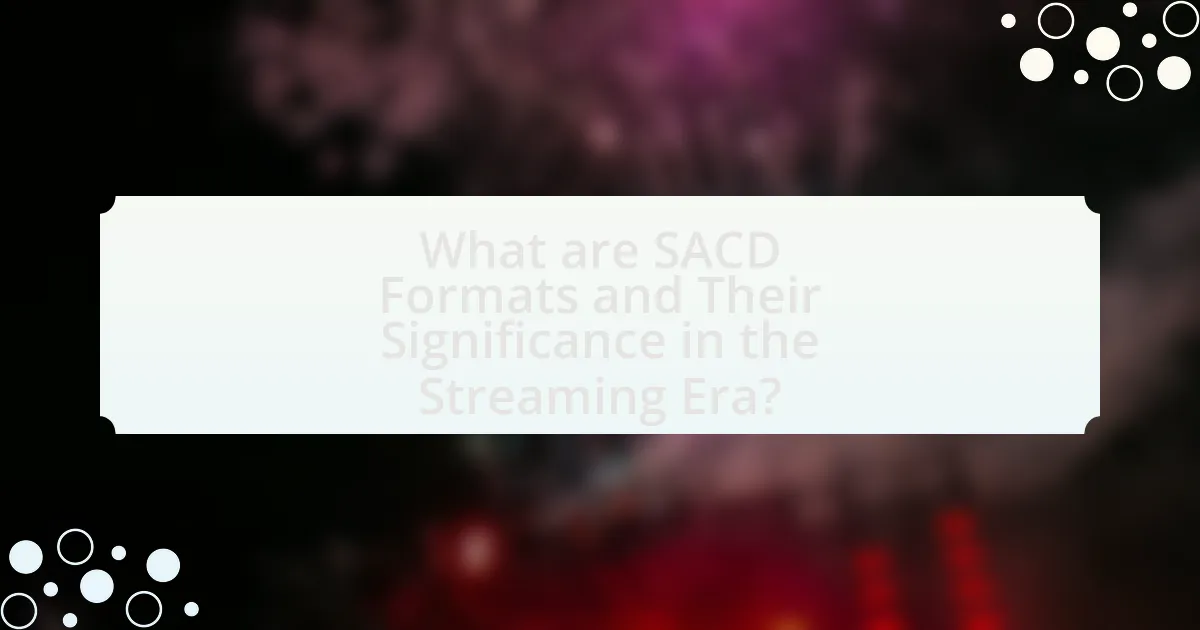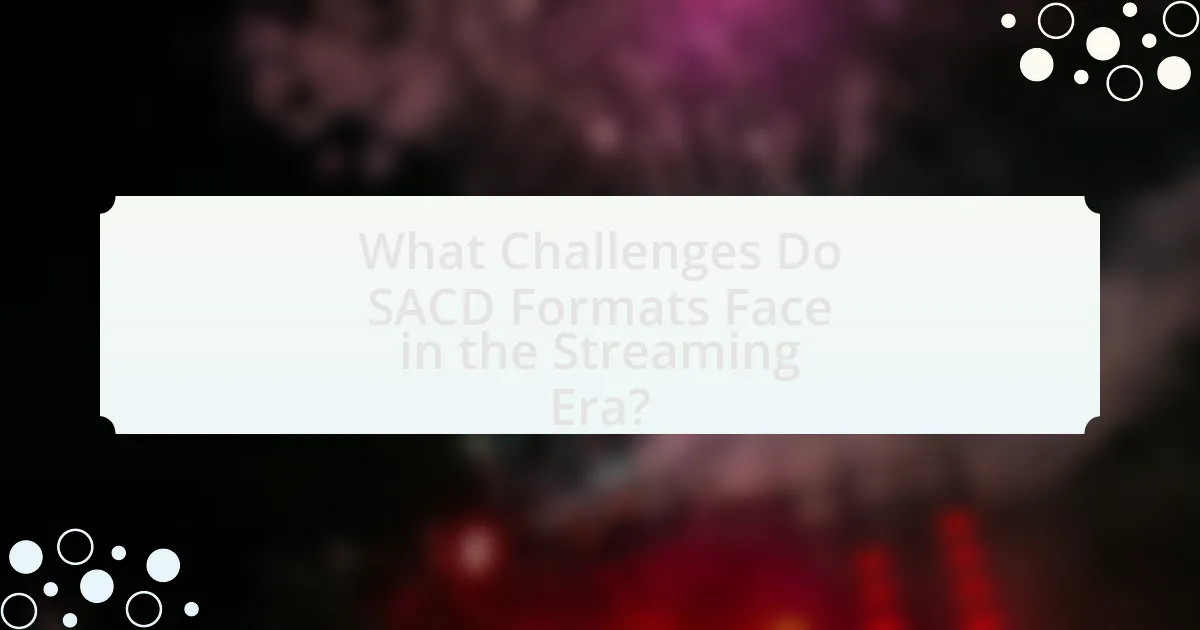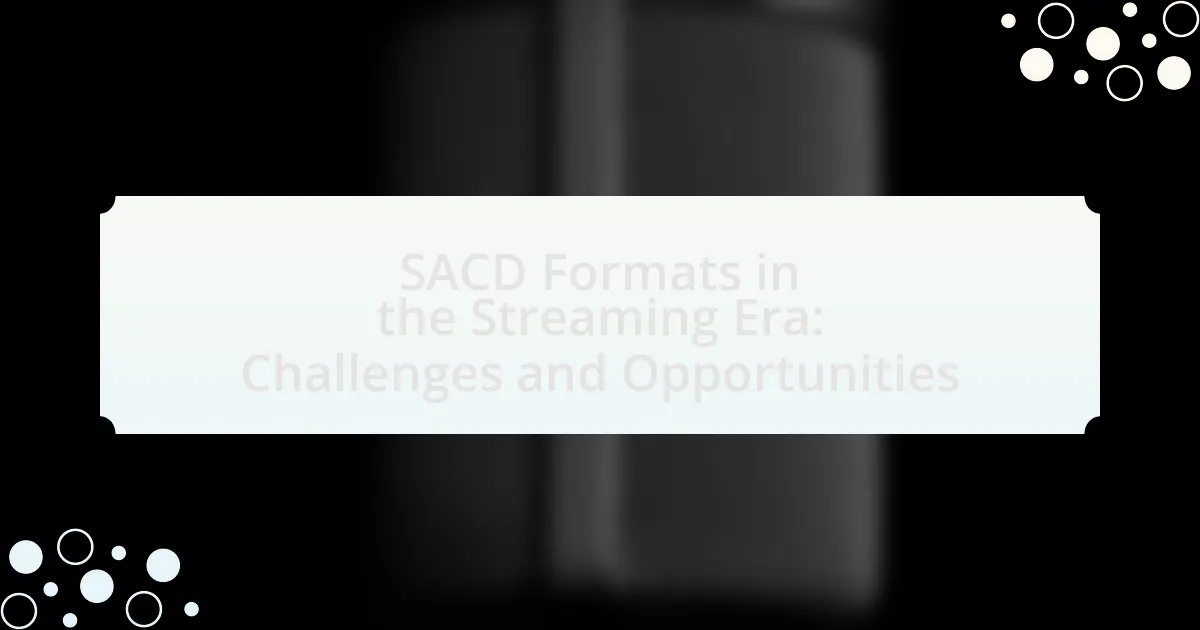SACD formats, or Super Audio CD formats, are high-resolution audio formats that provide superior sound quality compared to standard CDs, utilizing Direct Stream Digital (DSD) encoding. This article examines the significance of SACD formats in the streaming era, highlighting their appeal to audiophiles seeking high-fidelity audio experiences amidst the dominance of compressed streaming services. It discusses the technical specifications that define SACD formats, their role in the music industry, and the challenges they face, including competition from digital formats and limited consumer demand. Additionally, the article explores opportunities for SACD formats to thrive through strategic partnerships and technological advancements, emphasizing the importance of consumer education and best practices for maintaining relevance in a rapidly evolving audio landscape.
What are SACD Formats and Their Significance in the Streaming Era?

SACD formats, or Super Audio CD formats, are high-resolution audio formats designed to provide superior sound quality compared to standard CDs. Introduced in 1999, SACDs utilize a different encoding method called Direct Stream Digital (DSD), which allows for a greater dynamic range and more accurate reproduction of sound. In the streaming era, SACD formats hold significance as they cater to audiophiles seeking high-fidelity audio experiences that streaming services often do not provide. While streaming platforms typically compress audio files, SACDs maintain their high-resolution quality, making them appealing for critical listening environments. The continued interest in SACD formats highlights a niche market that values audio quality over convenience, demonstrating that even in a predominantly streaming-focused landscape, there remains a demand for superior sound reproduction.
How do SACD formats differ from traditional audio formats?
SACD formats differ from traditional audio formats primarily in their ability to deliver higher audio quality through multi-channel sound and higher sampling rates. SACD, or Super Audio CD, utilizes Direct Stream Digital (DSD) encoding, which allows for a greater dynamic range and frequency response compared to the Pulse Code Modulation (PCM) used in standard CDs and other traditional formats. This results in a more detailed and immersive listening experience, as SACDs can support up to 5.1 surround sound, while traditional formats typically offer stereo sound. The SACD format also has a higher bit depth and sampling frequency, often reaching 2.8 MHz, which is significantly higher than the 44.1 kHz standard of CDs, contributing to its superior sound fidelity.
What technical specifications define SACD formats?
SACD formats are defined by their use of Direct Stream Digital (DSD) encoding, which operates at a sampling rate of 2.8224 MHz, significantly higher than standard CD audio. This high-resolution audio format supports both stereo and multi-channel sound, allowing for up to six channels of audio at 1-bit depth. Additionally, SACDs can contain a hybrid layer, which includes a standard CD layer for compatibility with regular CD players, while the DSD layer is specifically designed for SACD playback. The specifications also include a maximum storage capacity of 4.7 GB for single-layer discs and 8.5 GB for dual-layer discs, enabling extensive audio content. These technical specifications ensure that SACD formats deliver superior audio quality compared to traditional formats.
Why are SACD formats considered high-resolution audio?
SACD formats are considered high-resolution audio because they utilize Direct Stream Digital (DSD) technology, which offers a sampling rate of 2.8224 MHz, significantly higher than the standard CD’s 44.1 kHz. This higher sampling rate allows for a more accurate representation of sound waves, resulting in improved audio fidelity and detail. Additionally, SACDs can store multi-channel audio, enhancing the listening experience by providing a more immersive sound environment. The combination of these technical specifications establishes SACD formats as a superior audio medium compared to traditional formats.
What role do SACD formats play in the current music industry?
SACD formats play a niche role in the current music industry by providing high-resolution audio quality that appeals to audiophiles and collectors. Despite the dominance of streaming services, SACDs offer a tangible product with superior sound fidelity, which is particularly valued in genres like classical and jazz. The format’s ability to deliver multi-channel audio enhances the listening experience, making it a preferred choice for enthusiasts seeking immersive sound. Additionally, the limited production runs and exclusive releases of SACDs create a sense of rarity and collectibility, further solidifying their position in a market increasingly focused on digital consumption.
How have consumer preferences shifted towards SACD formats?
Consumer preferences have shifted towards SACD formats due to a growing demand for high-fidelity audio experiences. This shift is evidenced by the increasing popularity of high-resolution audio formats among audiophiles and music enthusiasts, who seek superior sound quality that SACD provides compared to standard CDs and streaming services. According to a 2021 report by the International Federation of the Phonographic Industry, sales of high-resolution audio formats, including SACD, have seen a resurgence, indicating a renewed interest in physical media that offers enhanced audio performance.
What impact do SACD formats have on music production and distribution?
SACD formats significantly enhance audio quality in music production and distribution. By utilizing a higher sampling rate and bit depth compared to standard CDs, SACDs provide a more detailed and dynamic sound, which can influence the mixing and mastering processes. This superior audio fidelity encourages producers to adopt more meticulous recording techniques and can lead to a more immersive listening experience for consumers. Additionally, the niche market for SACDs can affect distribution strategies, as labels may focus on limited releases and specialized retailers to cater to audiophiles, thereby impacting overall sales dynamics in the music industry.
What Challenges Do SACD Formats Face in the Streaming Era?

SACD formats face significant challenges in the streaming era primarily due to the dominance of digital streaming services that prioritize convenience and accessibility over high-fidelity audio quality. The widespread adoption of streaming platforms like Spotify and Apple Music, which offer compressed audio formats, has led to a decline in consumer interest in physical media such as SACDs. Additionally, the limited availability of SACD players and the niche market for high-resolution audio further hinder the format’s growth. According to a report by the Recording Industry Association of America, physical media sales have been declining consistently, with streaming now accounting for over 80% of music revenue, illustrating the shift in consumer preferences away from formats like SACD.
How has the rise of streaming services affected SACD formats?
The rise of streaming services has significantly diminished the market demand for SACD formats. As consumers increasingly prefer the convenience and accessibility of streaming platforms, sales of physical media like SACDs have declined. For instance, data from the Recording Industry Association of America indicates that physical sales, including SACDs, have been consistently decreasing since the early 2000s, while streaming revenue has surged, reaching over $10 billion in 2020. This shift has led to fewer new SACD releases and limited support from major labels, as they prioritize digital formats that align with current consumer behavior.
What are the limitations of SACD formats in a streaming context?
SACD formats face significant limitations in a streaming context primarily due to their high-resolution audio requirements and proprietary nature. The high data rates associated with SACD, which can exceed 1.5 Mbps, make it challenging to stream effectively over typical consumer internet connections, especially in areas with limited bandwidth. Additionally, SACD uses DSD (Direct Stream Digital) encoding, which is not widely supported by streaming platforms, limiting accessibility and compatibility with standard audio devices. These factors hinder the widespread adoption of SACD in streaming services, as most platforms prioritize formats that are more universally compatible and easier to stream.
How do SACD formats compete with other high-resolution audio formats?
SACD formats compete with other high-resolution audio formats by offering superior sound quality through DSD (Direct Stream Digital) encoding, which provides a higher sampling rate than PCM (Pulse Code Modulation) used in formats like DVD-Audio and Blu-ray Audio. The SACD’s ability to deliver a more accurate representation of the original recording is supported by its 1-bit audio data stream, which can capture nuances in sound that other formats may miss. Additionally, SACDs often include multi-channel audio options, enhancing the listening experience compared to stereo-only formats. The competition is further influenced by the limited availability of SACD players and discs, which contrasts with the broader accessibility of formats like FLAC and streaming services that offer high-resolution audio.
What are the market challenges for SACD formats today?
The market challenges for SACD formats today include limited consumer demand, competition from digital streaming services, and a shrinking physical media market. Consumer interest in high-resolution audio formats like SACD has diminished as streaming platforms offer convenient access to vast music libraries at lower costs. Additionally, the rise of digital formats has led to a decline in sales of physical media, including SACDs, which are often seen as niche products. According to the Recording Industry Association of America, physical music sales have been declining for years, further impacting the viability of SACD formats in the current market landscape.
How do pricing and accessibility impact SACD adoption?
Pricing and accessibility significantly influence SACD adoption by determining consumer willingness to invest in the format. High prices for SACD players and discs can deter potential buyers, as evidenced by market trends showing that lower-priced alternatives, such as digital downloads and streaming services, dominate consumer preferences. Additionally, limited availability of SACD titles in mainstream retail channels restricts access, further hindering adoption. For instance, a study by the Consumer Electronics Association indicated that when SACD players were priced competitively and a broader selection of titles was available, adoption rates increased. Thus, both pricing strategies and accessibility to SACD products are critical factors in their market penetration.
What technological barriers exist for SACD formats in streaming?
SACD formats face several technological barriers in streaming, primarily due to their high-resolution audio capabilities and proprietary encryption methods. The high-resolution audio of SACD, which can include multi-channel sound, requires significant bandwidth and specialized codecs that are not universally supported by streaming platforms. Additionally, the DSD (Direct Stream Digital) encoding used in SACDs is not compatible with standard streaming formats, limiting its integration into existing streaming infrastructures. Furthermore, the copyright protection mechanisms inherent in SACD formats complicate their distribution over the internet, as they require specific licensing agreements and compliance with digital rights management (DRM) protocols. These factors collectively hinder the widespread adoption and streaming of SACD formats.
What Opportunities Exist for SACD Formats in the Streaming Era?

SACD formats have the opportunity to thrive in the streaming era by offering high-resolution audio that enhances the listening experience beyond standard streaming quality. As streaming services increasingly adopt high-fidelity options, SACD can cater to audiophiles seeking superior sound quality. The growing consumer demand for immersive audio experiences, such as surround sound, aligns with SACD’s capabilities, making it a viable option for niche markets. Additionally, partnerships with streaming platforms that support high-resolution audio formats can expand SACD’s reach, allowing it to tap into a broader audience that values audio fidelity.
How can SACD formats leverage streaming technology for growth?
SACD formats can leverage streaming technology for growth by integrating high-resolution audio streaming services that cater to audiophiles. This integration allows SACD content to reach a broader audience through platforms that support high-quality audio formats, enhancing user experience and accessibility. For instance, services like Tidal and Qobuz already offer high-resolution audio streaming, which aligns with the SACD’s superior sound quality. By partnering with these platforms, SACD can capitalize on the growing demand for high-fidelity music streaming, thus expanding its market presence and increasing sales.
What partnerships could enhance the visibility of SACD formats?
Strategic partnerships with high-end audio equipment manufacturers and streaming services could enhance the visibility of SACD formats. Collaborating with brands like Sony, which pioneered SACD technology, can leverage their established market presence and expertise in high-resolution audio. Additionally, partnerships with streaming platforms that support high-fidelity audio, such as Tidal or Qobuz, can facilitate the promotion of SACD content, making it more accessible to audiophiles. These collaborations can also include co-marketing efforts, educational campaigns about the benefits of SACD, and exclusive releases that highlight the superior sound quality of the format.
How can SACD formats be integrated into existing streaming platforms?
SACD formats can be integrated into existing streaming platforms by utilizing high-resolution audio streaming technologies that support DSD (Direct Stream Digital) encoding. This integration requires platforms to adopt codecs capable of handling SACD’s unique audio characteristics, such as the Super Audio CD’s multi-channel capabilities and higher sampling rates.
For instance, platforms like Tidal and Qobuz already offer high-resolution audio streaming, which could be expanded to include SACD formats by implementing DSD streaming. Additionally, partnerships with record labels that produce SACD content can facilitate the availability of SACD albums on these platforms, ensuring a diverse catalog for users.
The successful integration of SACD formats into streaming services would enhance the listening experience for audiophiles, as SACD is known for its superior sound quality compared to standard CD formats.
What innovations could drive the future of SACD formats?
Innovations that could drive the future of SACD formats include enhanced audio compression technologies and integration with streaming platforms. Enhanced audio compression can improve sound quality while reducing file sizes, making SACDs more accessible. Additionally, partnerships with streaming services could facilitate the distribution of SACD content, allowing users to experience high-resolution audio without the need for physical media. These innovations align with consumer trends towards digital consumption and the demand for superior audio experiences.
How can advancements in audio technology benefit SACD formats?
Advancements in audio technology can enhance SACD formats by improving sound quality and expanding playback options. For instance, developments in digital signal processing and high-resolution audio codecs allow SACDs to deliver superior audio fidelity, capturing a wider frequency range and dynamic range compared to standard CDs. Additionally, innovations in streaming technology enable SACD content to be streamed with high quality, making it more accessible to consumers. The integration of advanced audio formats, such as DSD (Direct Stream Digital), further optimizes the listening experience by providing a more accurate representation of the original recording. These technological improvements not only elevate the audio experience but also help SACD formats remain relevant in a competitive streaming landscape.
What role does consumer education play in promoting SACD formats?
Consumer education plays a crucial role in promoting SACD formats by informing potential users about the superior audio quality and unique features of SACD compared to standard formats. Educated consumers are more likely to appreciate the benefits of high-resolution audio, which can lead to increased demand for SACD products. For instance, studies have shown that when consumers understand the technical advantages, such as multi-channel sound and enhanced dynamic range, they are more inclined to invest in SACD players and discs. This understanding can be fostered through targeted marketing campaigns, demonstrations, and educational content that highlight the distinct advantages of SACD formats in the context of modern audio consumption.
What Best Practices Should Be Followed for SACD Formats in the Streaming Era?
Best practices for SACD formats in the streaming era include ensuring high-resolution audio delivery, optimizing metadata for discoverability, and maintaining compatibility with various playback systems. High-resolution audio is essential as it preserves the quality of SACD recordings, which are designed for superior sound fidelity compared to standard formats. Optimizing metadata enhances user experience by making it easier for listeners to find and access SACD content on streaming platforms. Compatibility with different playback systems, including both physical and digital formats, ensures that SACD content reaches a wider audience, thereby maximizing its potential in the streaming landscape. These practices are crucial for maintaining the relevance and appeal of SACD formats amidst evolving consumer preferences and technological advancements.

Leave a Reply